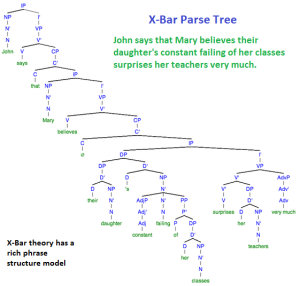22 Apr Breaking Down Language Structure and Function
 Grammar Acquisition
Grammar Acquisition
Some experts suggest that a correctly formulated adult grammar is acquired by children on the basis of sentences they hear in their first few years (Pinker, 1984, p. 5). The proponents of this theory assume that a young child perceives sentence structure or is able to detect elements of grammatical structure – a difficult assumption to defend. Perceiving patterns that eventually are understood to be grammatical is clearly happening, and perhaps this is what Pinker means.
In addition, many children who develop excellent speech proficiency at an early age are exposed to a rich mixture of incomplete and ungrammatical sentences, yet they are still able to sort it all out, suggesting innate grammar. Yet children who grow up in mixed-up environments where they get good examples of grammar patterns from mass media and poor examples from family, tend to adopt the poor grammar as their manner of speaking. This argues for less innate input and more nurture.
| Understanding Context Cross-Reference |
|---|
| Click on these Links to other posts and glossary/bibliography references |
|
|
|
| Prior Post | Next Post |
| Language Inherited | Form and Substance in Communication |
| Definitions | References |
| grammar acquisition | Pinker 1984 |
| perception pattern | Sowa 1984 |
| classify structure function | Duda 1973 |

Language structure and function are both learned from the earliest ages.
- The structure of a glass is a description of its properties: it is a cylindrical solid object with one end opened and the other end closed, and flat enough to stabilize the upright cylinder.
- The function is a description of usage: placed on a level horizontal surface with closed end down, it holds gasses, liquids and/or solids.
Perhaps the first sentence a child hears is the one that follows his/her introduction to the concept of a sentence. Before that, what the child may be hearing are just strings or patterns of words related to concepts in the mind. This theory describes early childhood speech as the expression of concepts in manageable symbol strings. Children classify different words as action words (verbs), object words (nouns), position words (prepositions) and other words needed to help them be understood.
Where grammaticality manifests itself in early childhood speech, it has nothing to do with understanding sentence structure; rather, it is based on ordering rules which tie words together as classified symbols. Some children form these patterns from the bottom up (word by word, to phrases then sentences – some with special training may even decompose words), while others think from the top down (beginning with the sentence and phrases). The patterns of word juxtaposition develop into a grammar.
The convenience of the sentence, as a segmentation vehicle, is only added to the grammar later in the learning process. Dividing chunks of spoken and written language into sentences is logical. In order to comprehend the symbols we use to express ideas, we need to break messages down into digestible segments. The most basic segments of language (phonemes, morphemes, sememes, and words) are too small, and rarely meaningful enough, to constitute useful message segments. Consequently, our chunking process or function must be tuned to the right granularity to be effective.  Phrases and sentences, however, serve as convenient segments for delivering message content. The basic question is this: What is the importance of the sentence as a unit in language learning and interpretation?
Phrases and sentences, however, serve as convenient segments for delivering message content. The basic question is this: What is the importance of the sentence as a unit in language learning and interpretation?
Content vs. Structure
Taking issue with the sentence-learning notion leads to a fundamental point: in the mind, syntax may not be related to sentences but, instead, tied to concepts and lexical entries. In other words, lexical entries are stored in the mind as symbols related to concepts, and syntactic constraints are linked to words as they relate to the concepts they express.  When background noise is present, both syntactic and semantic errors of any kind make sentences more difficult to understand, for both children and adults.
When background noise is present, both syntactic and semantic errors of any kind make sentences more difficult to understand, for both children and adults.
As Sowa points out, “children are relatively more sensitive to semantic errors than syntactic ones” (1984, p. 215). This may be because parents more often correct a child for content than structure. If both the parents’ corrections and the children’s sensitivities are based on a shared understanding that language is a symbol system for encoding world knowledge, then the structure is far less important then the underlying content. Remember, the earliest child language consists wholly of gestures and non-lexical sounds; this reliance on things other than words to convey meaning persists lifelong. Communication doesn’t really need words, much less grammatical sentences.
| Click below to look in each Understanding Context section |
|---|
| Intro | Context | 1 | Brains | 2 | Neurons | 3 | Neural Networks |
| 4 | Perception and Cognition | 5 | Fuzzy Logic | 6 | Language and Dialog | 7 | Cybernetic Models |
| 8 | Apps and Processes | 9 | The End of Code | Glossary | Bibliography |









I think that you are right that communication does not need words. As a teenager I used alot of slang and most of the sentence construct’s I used had the same words in them, but my intentions were always understood.For understanding my peers I used alot of intuition.